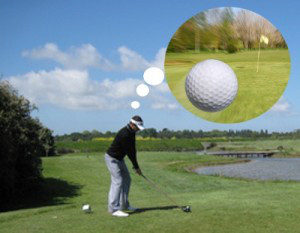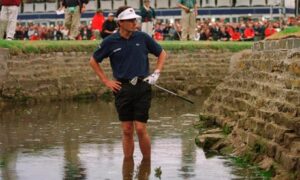Golf is a crazy game. It looks so simple but it’s so frustrating. You are only trying to swing a club at a stationary ball. That really should be easier than playing tennis or baseball where the ball is flying at you with different speeds and unexpected curves. Golf gives you as much time as you need to prepare for a shot. You can relax your mind and muscles and take full control of your body so why is it so damn difficult to consistently hit that stupid little ball?
Of course we all know that our personal emotions play a big part in our ability to consistently hit a perfect shot for every unique location of the ball. Practicing with GOLF TRAINING AIDS appear to be the best solution to improve our performance. So why is it that they turn out to be the MIRACLE CURE for some and a DUD for others?
1/ Unique Designs to Solve Specific Problem: Every Training Aid has been developed and tested by someone to create a more consistent swing. I designed GOLFSTR+ to remind me to keep my leading arm straight in the back swing. I immediately learned that I did not have the physical ability to rotate my body and arms like Rory McIlroy but I learned that by limiting my backswing AND KEEPING MY LEADING ARM STRAIGHT (WITH WRIST LAG), I was able to generate more powerful, consistent shots.
2/ Commitment to Succeed: Over time you may be able to develop more flexibility in your body but I quickly learned that flexibility in my shoulder and spine rotation does not happen overnight. You have to work with the physical limitations of your body. I have learned to accept the fact that I will never generate the power of those young bucks that we admire every week on the PGA Tour.
3/ Exercise to Improve Performance: We lose flexibility as we age but we can exercise to improve our performance. Golf-Info-Guide by Thomas Golf provided a simple stretch exercise at the end of this video: Right Way to Keep YOUR Left Arm Straight. Copy this URL and paste it in your browser: http://golf-info-guide.com/video-golf-tips/the-right-way-to-keep-your-left-arm-straight-video/
4/ Endorsement by a Professional: Anyone can pay enough money to get a professional to endorse a golf training aid. Pros don’t need to use GOLFSTR+ to remind them to keep their leading arm straight. They do it naturally. Fortunately pros RECOMMENDED 5 MORE USES for GOLFSTR+ to improve putting, chipping and lag training to generate more power and distance. Michael Breed (a PGA Certified Trainer on the Golf Channel) complimented me personally for developing a training aid with “6 swing fixes that you can just slide in your pocket”. GOLFSTR+ really is the Swiss Army Knife of golf training aids.
5/ Pay Attention to Testimonials by Real Users: Rich Gula, a 70 year old golfer from the Boston area with a handicap index of 11 responded to my recent weekly blog “Get Your Game Back on Track!”
“Great stuff to start the New Swing Year! Bought your device some time ago and love it! It’s a very worthy successor to “The Bickler” of many years ago and “The Secret” of The Shark! Your support online however is superb! Your emphasis on fundamentals with the GOLFSTR+ keeps the ball in the fairway. The device is truly helpful for improving shots 50 yards or less as well. Thank you! “ Rich Gula
The Bickler was endorsed by Ken Venturi and John Cook to lock your wrists in a V shape for every putt. Greg Norman’s “The Secret” controls the angle of your trailing wrist for every shot in your game. GOLFSTR+ gives you both of these training solutions and so much more. Buy one today at www.golfstr.com
CORRECTION NOTICE FOR RULES UPDATE PUBLISHED DECEMBER 24
5/ Imbedded Ball in a Bunker: You can move the ball back and drop it in the bunker for a 1 stroke penalty or out of the trap on a line to the green for a 2 stroke penalty.
6/ Yellow Penalty Area (stream or canyon): drop ball back on a line to the green from the point of entry (1 stroke). Red Penalty Area (woods and water): If the ball is lost, estimate the point where the ball was lost, return to the fairway an equal distance to the hole from the point of entry and drop within 2 club lengths of the edge of the fairway as far back as you want to go. (2 stroke penalty). Ideally you should hit a provisional ball whenever you think your ball could be lost in a Red Stacked Penalty Area. (Your provisional ball, if needed, is lying 3 off the tee or take a stroke and distance at the point where you last hit.)














